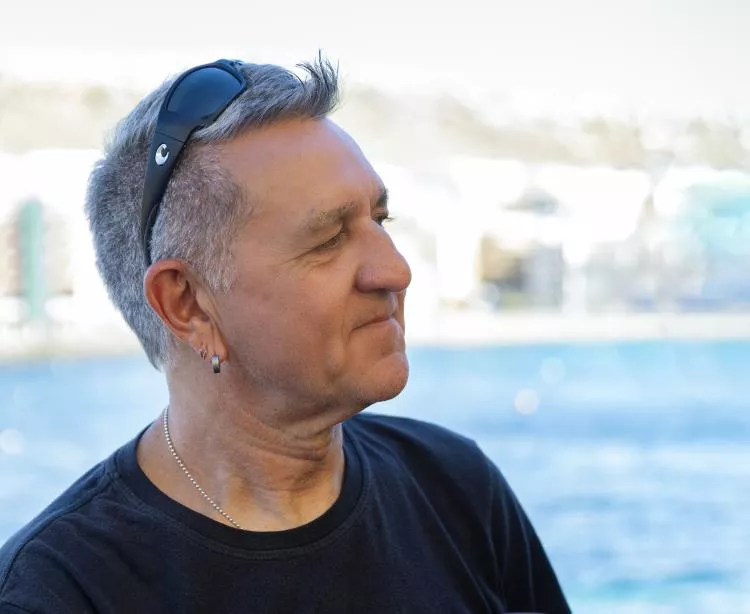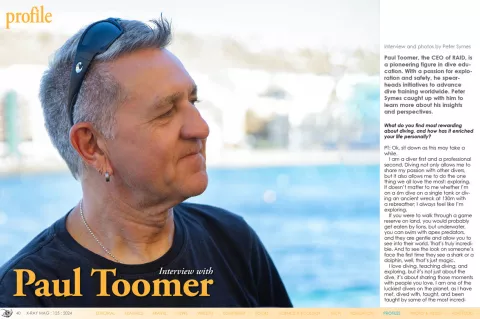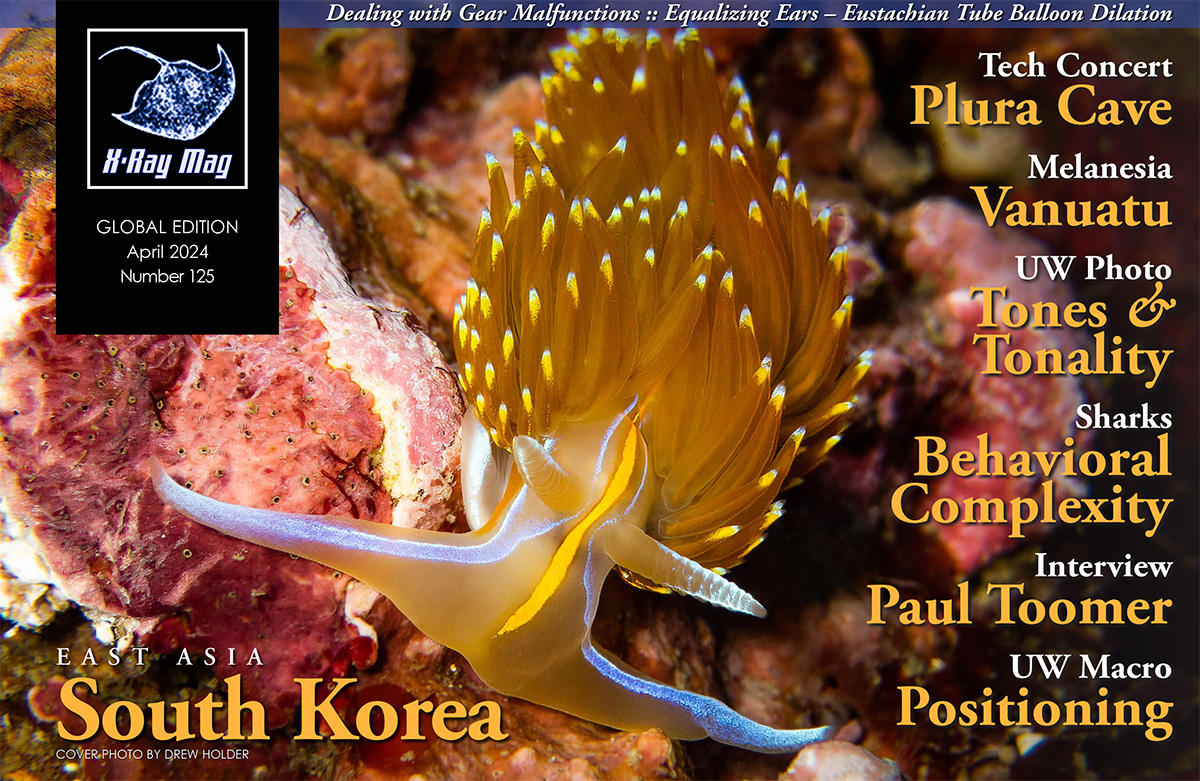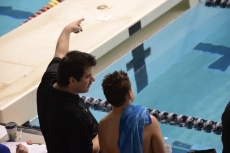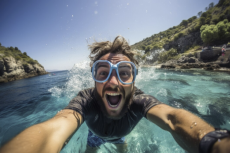Paul Toomer, the CEO of RAID, is a pioneering figure in dive education. With a passion for exploration and safety, he spearheads initiatives to advance dive training worldwide. Peter Symes caught up with him to learn more about his insights and perspectives.
Contributed by
What do you find most rewarding about diving, and how has it enriched your life personally?
PT: Ok, sit down as this may take a while.
I am a diver first and a professional second. Diving not only allows me to share my passion with other divers, but it also allows me to do the one thing we all love the most: exploring. It doesn’t matter to me whether I’m on a 6m dive on a single tank or diving an ancient wreck at 130m with a rebreather; I always feel like I’m exploring.
If you were to walk through a game reserve on land, you would probably get eaten by lions, but underwater, you can swim with apex predators, and they are gentle and allow you to see into their world. That’s truly incredible. And to see the look on someone’s face the first time they see a shark or a dolphin, well, that’s just magic.
I love diving, teaching diving, and exploring, but it’s not just about the dive, it’s about sharing those moments with people you love. I am one of the luckiest divers on the planet, as I have met, dived with, taught, and been taught by some of the most incredible people. This industry has been very kind to me, that’s for sure.
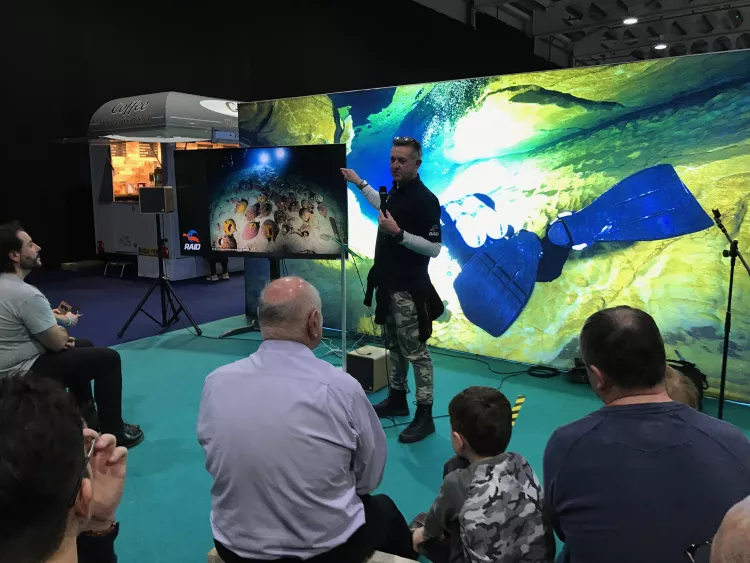
When you acquired RAID, what was your initial vision for the organisation, and how has that vision evolved over time?
PT: I have been an instructor and trainer with many amazing training agencies, and I have been lucky enough to learn with some spectacular people. I wanted to meld all I had seen and learned into one training platform.
When we started writing the training materials, we knew that our legacy was technical and rebreather diving, but we so badly wanted to engage with the recreational diving community. So, we built, and continue to build, courses that cross the divide and give divers the very latest in technology, equipment, and diving skill advancements. We were the first to bring neutral buoyancy while in trim diving into the mainstream, and to see new open water divers master so easily, what so many perceive as difficult, is utterly amazing.
We have done amazingly well, and we have released some incredible courses and initiatives. My two favourite initiatives are Zero Fee Membership and FREe-Learning. With Zero Fee Membership, we became, and still are, the only professional agency that does not charge a membership fee to active professionals. The release of FREe-Learning allows anyone who registers with RAID to download virtually all of our course materials for free—everything from Open Water 20 Diver to Hypoxic Trimix Rebreather.
However, there is so much more that I still want to see RAID and myself achieve. I’m never satisfied, and neither are any of our team members. With the team we have at headquarters, and with all the incredible RAIDers who discuss their ideas with us, I think we are going to bring so many more incredible things to this amazing industry. RAID will lead the way.
My dream is to leave the industry in a better state than we found it.
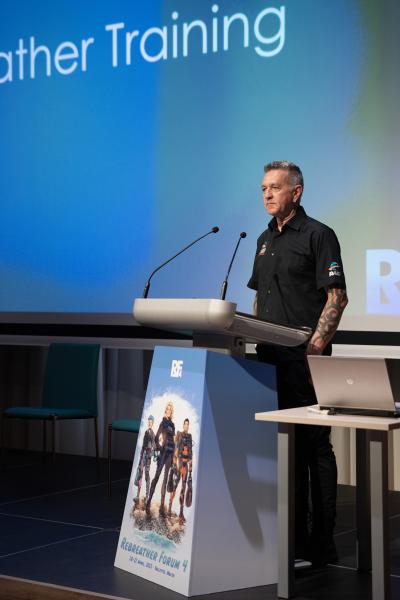
What are the main challenges associated with current teaching methods in diving, and what improvements or developments would you like to see in the industry?
PT: Teaching methods are definitely changing, and in many cases for the better. It’s always a balance between quantity and quality, right? You can have loads of divers on a course, but will the quality be there? I know so many professionals who have made quality and safety their main focus, and they are extremely successful, and happy too.
I want to see general diving become safer too. Generally, people do not like change, but our industry is rallying together to try and change it up a gear. Look at how many professionals and divers are using a long hose setup in recreational diving. Look at how important buoyancy and trim have become even for new open water divers, not just the tech divers.
I love that we have such inter-agency cooperation as well. A fine example of this is the Rebreather Training Council (RTC). Many of the world’s leading agencies have worked diligently together to try and make rebreather diving safer, and this has resulted in many great safety initiatives and also the production of the new rebreather ISO standards.
How can we effectively integrate technology, e-learning, and in-person instruction to enhance dive training?
PT: Just do a RAID course. It’s already there, ha, ha.
With e-learning, the landscape of teaching has changed quite a bit as most instructors have moved from delivering a formal presentation with a slide deck to prescriptive teaching where only missed questions are answered.
Instructors are, and always will be, the most important part of any diver’s education. Training agencies provide training standards and course materials that guide the instructor in achieving the desired outcome.
Instructors not only interact with the student in the water, but they also (in reality) interact verbally to confirm that all knowledge is understood.
At RAID, we have a series of workshops that our instructors must deliver on every course. The workshops are designed to fill in the gaps that a manual simply cannot provide. These range from “What will it be like where we are diving and what will we see?” to equipment and continuing education. While doing this, vital safety information is also discussed.
Recently, however, we have started to receive requests for old-style PowerPoint presentations, which is quite incredible considering we live in such a digital, fast-paced world.
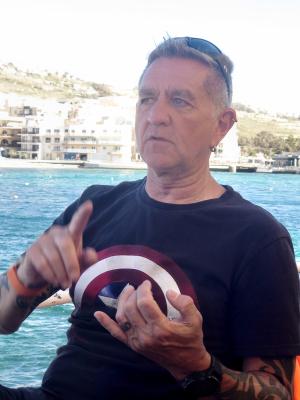
Encouraging try-divers to continue with training and diving can be a challenge. What strategies do you recommend to keep them interested?
PT: This is very difficult, and I know that the entire industry is trying its best to overcome this challenge.
We live in a world where we have a “bucket list” of things we want to do. It is all about instant gratification and I believe many industries are challenged by that. For example, I do a tandem skydive and I am now a skydiver. I go to a skate park, and I get an hour on a board, I am now a skater. So, we should not be surprised that people do a try dive and then consider themselves a diver and that bucket list item is now ticked off.
All of the successful dive centres that I have seen that convert try divers into qualified open water divers and beyond, spend a lot of time nurturing their relationship with the customer and ensuring that the try-dive experience is not only fun but safe.
They follow up and, in some cases, even recommend another dive centre closer to home to make it easier for the student to become a certified diver.
Many try-dive participants will do the experience at the drop of a hat. Perhaps they are on a cruise ship, and the experience is offered at one of the exotic stop-offs. In this case, they do not have time to sign up for the full course and will probably live far away. If the try dive is an official agency-backed experience, using agency materials, then the agency can follow up and provide information on local dive centres close to where the try diver lives.
One of the big problems we see in the industry is that some dive centres do not use official materials, and when this happens, there is usually no student registration, making it difficult for the training agency to follow up.
Having said that, thousands and thousands of try-dive participants go on to become certified divers.
Diving often involves significant costs and training requirements. Do you believe there are ways to mitigate these barriers, and should efforts be made to do so?
PT: This question comes up all the time.
If I were to reword the question, it would be: “Does diving involve significant costs?” My answer to that would be NO.
As a certified diver you have a passport that allows you to dive over 70% of the planet. How amazing is that?
Yes, you need equipment, and you may have to travel to your destination, but how much is spent on equipment and travel in other sports? Skiers, golfers, mountain bikers, and motorcyclists all spend a fortune on their sport. I went to look at a good mountain bike the other day, and it cost GB£5,000 (US$6,360) and there was absolutely no option for a discount. Yet that store can’t get the product in fast enough.
As professional divers and dive store owners, we need finance to stay in business, and lowering course prices often dilutes the quality of the course.
What safety measures and practices do you personally prioritise to ensure a safe and comfortable diving experience? Are there any tips you can share to make diving more enjoyable?
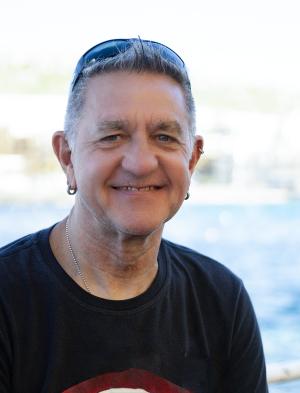
PT: I have many.
My first rule is the “rule of thirds.” I apply this not only to my diving gas, but also to other things like preparing for the dive. If I have three issues, I will cancel my dive immediately. It sounds superstitious, but it has worked for me for over 25 years.
When I arrive at the dive site, my first assessments are the “exit” and “entry” points. It’s often easy to get into the water, but it may be impossible to get out.
In addition to the above, I ask the team if we are all able to rescue each other and get out of the water easily. If the answer is no, then the dive is aborted.
Do you have a role model or a source of inspiration outside of the diving world that has influenced your personal growth and development?
PT: Lots of people have been amazing to me in all the crazy things I’ve done, but it has to be my dad. I admire everything he has done and all that he has given me. I could write a book on the guy. You think I’m crazy, he makes me look tame—except for the tattoos.
If you could give one piece of advice to your 25-year-old self, what would it be, given your experiences and insights into the dive industry?
PT: That’s easy. I’d tell myself to learn to dive earlier. I did not learn to dive until I was 30, and I am so sad that I missed all those years.
I have no other advice for my 25-year-old self, as everything I have done has been worthwhile, exciting, and hugely enjoyable. I have had, and continue to have, the best life that I could ever wish for, and it’s all due to my desire and those around me helping me to achieve it.
When my grandad was dying, he said to me, “It is better to be born lucky than rich,” and I was born lucky. That says it all, really. ■
For more information, please visit: diveraid.com.

